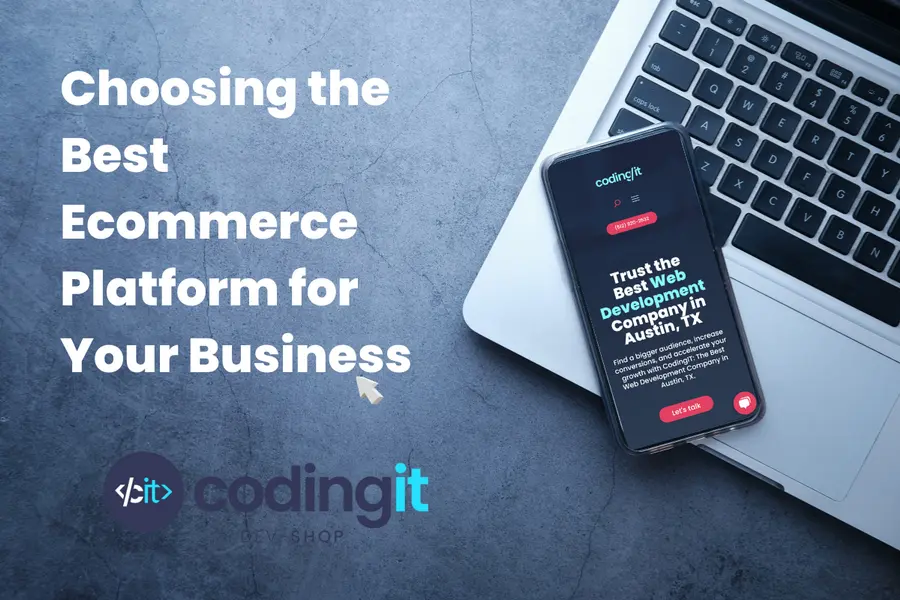The Ecommerce Platform You Choose Matters.
If you’re thinking about starting an online store, one of the most important decisions you’ll make is choosing an ecommerce platform. The platform you choose will determine how easy it is to set up and manage your store, how much you can customize it, and how much it will cost.
There are a lot of different ecommerce platforms out there, so it can be tough to know which one is right for you. That’s why I’ve put together this guide to help you choose the best ecommerce platform for your business.
In this guide, we will compare the four most popular ecommerce platforms: Shopify, WooCommerce, Wix, and BigCommerce. We will go on to discuss the key factors to consider when choosing an ecommerce platform, such as your budget, your technical expertise, and your specific needs.
So whether you’re a complete beginner or you’re just starting to research ecommerce platforms, this guide is for you. By the end of this guide, you’ll know which ecommerce platform is right for your business and how to get started.
Here’s what we’ll cover:
- The Four Most Popular Ecommerce Platforms
- The Key Factors to Consider When Choosing an Ecommerce Platform
- A Detailed Comparison of the Four Platforms
- Conclusion
It is our hope that this guide helps you choose the best ecommerce platform for your business. So let’s get started!
The Four Most Popular Ecommerce Platforms
Keep calm, we know there are more than four! But, based upon our experience, these are the 4 most common ecommerce platforms that we are asked about. If you want your opinion expressed, please feel free to write about it on your blog to share with the world.
So, that being acknowledged, the four most popular ecommerce platform providers are:
- Shopify: Shopify is a hosted platform, which means that you don’t need to worry about hosting or maintenance. It’s also easy to use and has a lot of features, making it a good choice for beginners.
- WooCommerce: WooCommerce is a self-hosted platform, which means that you need to find a web hosting provider and install the software yourself. It’s more customizable than Shopify, but it’s also more complex to set up and manage.
- Wix: Wix is a drag-and-drop platform that’s easy to use, even if you don’t have any technical experience. However, it’s not as customizable as Shopify or WooCommerce.
- BigCommerce: BigCommerce is a powerful platform that offers a lot of features and flexibility. However, it’s also more expensive than Shopify or WooCommerce.

The Key Factors to Consider When Choosing an Ecommerce Platform
When choosing an ecommerce platform, there are a few key factors to consider:
- YOUR budget: Ecommerce platforms can range in price from free to thousands of dollars per month. It’s important to have a budget and choose a platform that fits your budget.
- YOUR technical expertise: If you’re not very technical, you’ll want to choose a platform that’s easy for YOU to use. No code options are great, but if you don’t have the time to learn these platforms, then you will have to pay for assistance. Otherwise, you might want to choose a self-hosted platform so you can have more control over the development process.
- Your specific needs: What features are important to you? Do you need a platform that can handle a lot of traffic? Do you need a platform that’s easy to integrate with your existing systems? Do you need the design done for you?
- YOUR target audience: What are your customers’ needs and expectations? What kind of experience do you want them to have on your website? What platforms are competitors using?
- YOUR marketing strategy: How do you plan to market your products or services? Do you need a platform that can handle a lot of traffic? Do you need SEO tools embedded?
- YOUR future growth plans: Do you plan to expand your product offerings or start selling internationally? What is your anticipated monthly traffic volume for the next 2 years? You’ll need a platform that can accommodate growing with your business.
Ultimately, the best ecommerce platform for you will depend on your specific needs and budget. It’s important to do your research and try out a few different platforms before making a decision. Afterall, they offer a trial for a reason, they know it’s not an easy decision to make.
A Detailed Comparison of the Four Platforms
Here is a more detailed look at the four most common platform choices:
 | ||||
| Current Pricing | Shopify Pricing | WooCommerce Pricing | Wix Pricing | BigCommerce Pricing |
| Free plan or free trial | 14-day free trial | Free plan | Free plan | Free trial |
| Transaction fees | ✅ | ✅ | ❌ | ❌ |
| Multiple inventory locations | ✅ | ✅ | ❌ | ❌ |
| App marketplace | ✅ | ✅ | ✅ | ✅ |
| Domain management | ✅ | ✅ | ✅ | ✅ |
| Assign team roles and permissions | ✅ | ✅ | ✅ | ✅ |
| Large user community | ✅ | ✅ | ❌ | ❌ |
| Mobile-friendly | ✅ | ✅ | ✅ | ✅ |
| Features | ||||
| Reports | ✅ | ✅ | ✅ | ✅ |
| Product categories | ✅ | ✅ | ✅ | ✅ |
| Manual order creation | ✅ | ✅ | ❌ | ✅ |
| BOPIS (buy online pickup in store) | ✅ | ✅ | ✅ | ✅ |
| Customizable checkout | ✅ | ✅ | ✅ | ✅ |
| Product variations (variants) | ✅ | ✅ | ✅ | ✅ |
| Multichannel integrations | ✅ | * | ✅ | ✅ |
| Abandoned cart recovery | ✅ | * | ✅ | ✅ |
| Discounts/coupons | ✅ | ✅ | ✅ | ✅ |
| Gift cards | ✅ | * | * | ✅ |
| Subscriptions | ✅ | * | ✅ | * |
| Payments | ||||
| Fraud analysis | ✅ | * | * | * |
| Key payment integrations | Stripe, PayPal, Apple Pay, Amazon Pay, Shopify payments | Stripe, PayPal, Square, WooCommerce payments | Stripe, PayPal, Square, Authorize.net, Wix payments | Stripe, PayPal, Apple Pay, Amazon Pay, Authorize.net |
| Global Selling | ||||
| Multicurrencies | ✅ | * | ✅ | ✅ |
| Multiple languages | ✅ | * | ✅ | * |
| Shipping | ||||
| Shipping discount | ✅ | * | * | * |
| Shipping labels | ✅ | ✅ | ✅ | ✅ |
| Dropshipping | ✅ | * | ✅ | * |
| Shipping calculator | ✅ | * | ✅ | ✅ |
| Marketing | ||||
| Email marketing | ✅ | * | * | * |
| Advertising features | ✅ | * | * | * |
| SEO (search engine optimization) | ✅ | * | ✅ | ✅ |
| Blog | ✅ | ✅ | ✅ | ✅ |
| Social posts | ✅ | * | ✅ | ✅ |
| Video maker | * | * | * | * |
| Automations (e.g. welcome, thank you) | ✅ | * | * | * |
| Google Analytics integration | ✅ | * | * | * |
| Facebook Pixel integration | ✅ | * | * | * |
| Live chat | * | * | * | * |
| Forms | * | * | * | * |
| Design | ||||
| Templates | ✅ | ✅ | ✅ | ✅ |
| Drag-and-drop interface | * | ❌ | ✅ | ❌ |
| Support | ||||
| 24/7 phone, live chat, email, forums, online resources | 24/7 phone, email, forums, online resources | 24/7 phone, live chat, email, forums, online resources | 24/7 phone, live chat, email, forums, resources | |
| Best For | ||||
| Small to Mid-Size businesses looking for ease of use, a large app ecosystem, and marketing tools. | WordPress-built websites and businesses looking for high customization with a large community. | Small businesses looking for flexibility, some customization, marketing tools, and some integrations to common applications. | Medium to large businesses that are looking for scalability, and many product options. Works well with Azure frameworks and Microsoft Dynamics |
*Available as Add-On or 3rd party application.
Of course if that table isn’t good enough for you and you want an even simpler way of thinking about each ecommerce platform, here is an easy to understand pros and cons list for each platform:
| PROS | CONS | |
| Easy to use Has a lot of features Hosted platform, so you don’t need to worry about hosting or maintenance Good choice for beginners Large and active community of users and developers Wide range of themes and plugins available | Can be expensive, especially for larger businesses Not as customizable as WooCommerce Some features are locked behind paid plans | |
| Highly customizable Self-hosted platform, so you have more control over your site Wide range of themes and plugins available Can be integrated with a wide variety of third-party services | Can be more complex to set up and manage than Shopify Requires more technical expertise Need to find a web hosting provider and install the software yourself | |
 | Easy to use, even if you don’t have any technical experience Drag-and-drop interface Wide range of features and templates available | Not as customizable as Shopify or WooCommerce Can be expensive for more advanced features Some users have reported issues with customer support |
| Powerful platform with a lot of features Offers a lot of flexibility and scalability Good choice for businesses that need to handle a lot of traffic | Expensive, especially for larger businesses Not as easy to use as Shopify Can be complex to set up and manage |
Conclusion
The best way to choose the right ecommerce platform for your business is to try out a few different ones and see which one suits your specific use case the best. There are a multitude of resources available to answer just about any question that you can think of, but there is no substitute to real world experience with a tool.
A common suggestion we have for those that are suffering from analysis paralysis is to encourage them to speak with other businesses that have used different platforms to get their recommendations. Or, better yet, speak to those businesses that operate in the same or similar industry. Questions such as what do they love and hate about the platform they chose? Did it meet or exceed their expectations? And, asking if they would they make the same decision knowing what they know now are all fantastic ways of learning through other people’s perspectives.
If all of that fails and you’re still not sure which platform is right for you, you can always contact a custom ecommerce web development company for help. CodingIT and our team of industry leaders would be happy to discuss your use case and make a suggestion based upon your vision and mission. Reach out to us today to learn more about why a platform may or may not be the best for your business in the long term.
